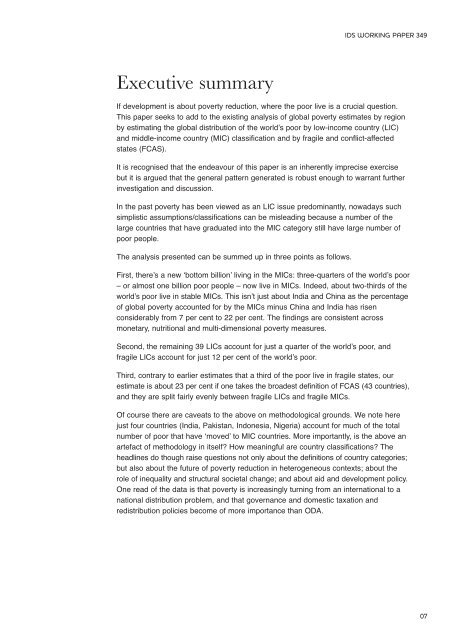Andy Sumner - Institute of Development Studies
Andy Sumner - Institute of Development Studies
Andy Sumner - Institute of Development Studies
You also want an ePaper? Increase the reach of your titles
YUMPU automatically turns print PDFs into web optimized ePapers that Google loves.
IDS WORKING PAPER 349Executive summaryIf development is about poverty reduction, where the poor live is a crucial question.This paper seeks to add to the existing analysis <strong>of</strong> global poverty estimates by regionby estimating the global distribution <strong>of</strong> the worldʼs poor by low-income country (LIC)and middle-income country (MIC) classification and by fragile and conflict-affectedstates (FCAS).It is recognised that the endeavour <strong>of</strong> this paper is an inherently imprecise exercisebut it is argued that the general pattern generated is robust enough to warrant furtherinvestigation and discussion.In the past poverty has been viewed as an LIC issue predominantly, nowadays suchsimplistic assumptions/classifications can be misleading because a number <strong>of</strong> thelarge countries that have graduated into the MIC category still have large number <strong>of</strong>poor people.The analysis presented can be summed up in three points as follows.First, thereʼs a new ʻbottom billionʼ living in the MICs: three-quarters <strong>of</strong> the worldʼs poor– or almost one billion poor people – now live in MICs. Indeed, about two-thirds <strong>of</strong> theworldʼs poor live in stable MICs. This isnʼt just about India and China as the percentage<strong>of</strong> global poverty accounted for by the MICs minus China and India has risenconsiderably from 7 per cent to 22 per cent. The findings are consistent acrossmonetary, nutritional and multi-dimensional poverty measures.Second, the remaining 39 LICs account for just a quarter <strong>of</strong> the worldʼs poor, andfragile LICs account for just 12 per cent <strong>of</strong> the worldʼs poor.Third, contrary to earlier estimates that a third <strong>of</strong> the poor live in fragile states, ourestimate is about 23 per cent if one takes the broadest definition <strong>of</strong> FCAS (43 countries),and they are split fairly evenly between fragile LICs and fragile MICs.Of course there are caveats to the above on methodological grounds. We note herejust four countries (India, Pakistan, Indonesia, Nigeria) account for much <strong>of</strong> the totalnumber <strong>of</strong> poor that have ʻmovedʼ to MIC countries. More importantly, is the above anartefact <strong>of</strong> methodology in itself? How meaningful are country classifications? Theheadlines do though raise questions not only about the definitions <strong>of</strong> country categories;but also about the future <strong>of</strong> poverty reduction in heterogeneous contexts; about therole <strong>of</strong> inequality and structural societal change; and about aid and development policy.One read <strong>of</strong> the data is that poverty is increasingly turning from an international to anational distribution problem, and that governance and domestic taxation andredistribution policies become <strong>of</strong> more importance than ODA.07
















